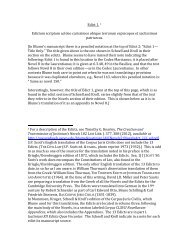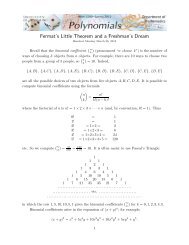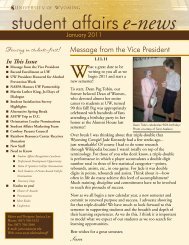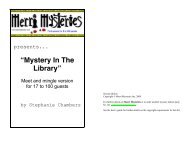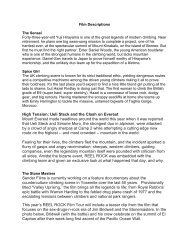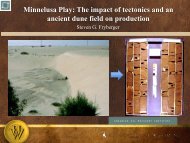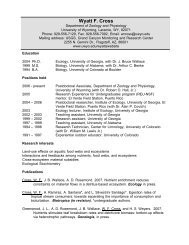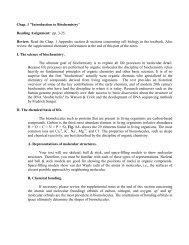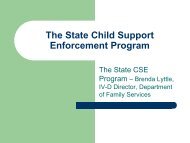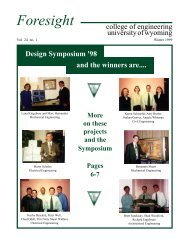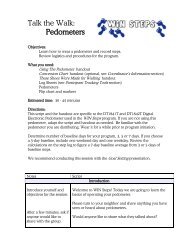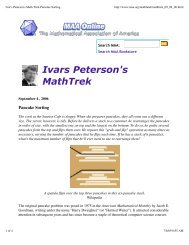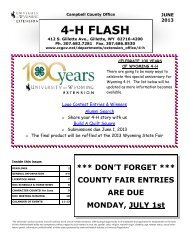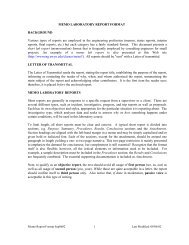microhabitat selection for nesting and brood-rearing by the greater ...
microhabitat selection for nesting and brood-rearing by the greater ...
microhabitat selection for nesting and brood-rearing by the greater ...
You also want an ePaper? Increase the reach of your titles
YUMPU automatically turns print PDFs into web optimized ePapers that Google loves.
84 CHRISTOPHER P. KIROL et al.<br />
FIGURE 1. Probability of sage-grouse use of <strong>microhabitat</strong> <strong>for</strong><br />
<strong>nesting</strong>, early <strong>brood</strong> <strong>rearing</strong>, <strong>and</strong> late <strong>brood</strong> <strong>rearing</strong> as a function of<br />
sagebrush canopy cover with 95% confidence intervals around predictions,<br />
south-central Wyoming, 2008 <strong>and</strong> 2009. Probability graphs<br />
derived from single-variable models. Sagebrush canopy cover was<br />
truncated on <strong>the</strong> basis of its median values in our data or its upper<br />
limits reported in <strong>the</strong> Hagen et al. (2007) meta-analysis.<br />
little to no support, yet <strong>the</strong> mean values of <strong>the</strong>se variables at<br />
used locations was slightly higher than at r<strong>and</strong>om locations<br />
(9.5 ± 1.1% vs. 8.5 ± 1.1% <strong>and</strong> 11.0 ± 1.1% vs. 10.8 ± 1.0%,<br />
respectively).<br />
DISCUSSION<br />
Our study design enabled us to assess <strong>the</strong> importance of several<br />
<strong>microhabitat</strong> variables in <strong>the</strong> context of a priori in<strong>for</strong>mation<br />
derived from research on <strong>the</strong> sage-grouse’s habitat<br />
<strong>selection</strong> while exploring additional <strong>microhabitat</strong> variables<br />
we <strong>the</strong>orized may be biologically relevant. By grouping variables<br />
into hypo<strong>the</strong>sis sets <strong>for</strong> three stages of <strong>the</strong> breeding cycle<br />
we were able to compare <strong>selection</strong> in our study areas to<br />
predictive <strong>microhabitat</strong> variables with varying degrees of<br />
support from previous research. Variance decomposition enabled<br />
us to quantify how much in<strong>for</strong>mation was explained <strong>by</strong><br />
each hypo<strong>the</strong>sis set <strong>and</strong> compare this to <strong>the</strong> results of previous<br />
research (e.g., Hagen et al. 2007).<br />
In south-central Wyoming <strong>nesting</strong> sage-grouse showed<br />
strong <strong>selection</strong> <strong>for</strong> physiognomic characteristics including<br />
sagebrush cover <strong>and</strong> visual obstruction (both represented in<br />
hypo<strong>the</strong>sis set Nest I). Similarly, we found that during early<br />
<strong>and</strong> late <strong>brood</strong> <strong>rearing</strong>, female grouse also preferred areas with<br />
more sagebrush cover (represented in Early-<strong>brood</strong> II <strong>and</strong> Late<strong>brood</strong><br />
II) than r<strong>and</strong>omly available. Late in <strong>brood</strong> <strong>rearing</strong> hens<br />
used areas with taller sagebrush plants (represented in Late<strong>brood</strong><br />
II) than r<strong>and</strong>omly available. During early <strong>and</strong> late <strong>brood</strong><br />
<strong>rearing</strong>, females disproportionately used habitats with cover of<br />
perennial grass <strong>greater</strong> than at r<strong>and</strong>om locations (represented in<br />
Early-<strong>brood</strong> I <strong>and</strong> Late-<strong>brood</strong> I). Likewise, nest <strong>selection</strong> was<br />
positively associated with <strong>greater</strong> total grass cover (represented<br />
in Nest II). We did not identify a correlation between <strong>greater</strong><br />
<strong>for</strong>b cover or food <strong>for</strong>b cover (represented in Early-<strong>brood</strong> I,<br />
Late-<strong>brood</strong> I, Early-<strong>brood</strong> II, <strong>and</strong> Late-<strong>brood</strong> II, respectively)<br />
<strong>and</strong> <strong>microhabitat</strong> <strong>selection</strong> during early or late <strong>brood</strong>-<strong>rearing</strong>.<br />
Less studied <strong>microhabitat</strong> variables in our models proved<br />
predictive of site <strong>selection</strong> <strong>for</strong> nests <strong>and</strong> late <strong>brood</strong> <strong>rearing</strong>.<br />
Nest <strong>selection</strong> was positively correlated with <strong>greater</strong> litter <strong>and</strong><br />
negatively correlated with cheatgrass (represented in Nest<br />
II <strong>and</strong> Nest III, respectively), <strong>and</strong> late in <strong>brood</strong> <strong>rearing</strong> hens<br />
selected <strong>microhabitat</strong>s with less biological soil crust (represented<br />
in Late-<strong>brood</strong> III). Floristically, we found Mountain<br />
big sagebrush was preferred over Wyoming big sagebrush <strong>for</strong><br />
<strong>nesting</strong> (represented in Nest III).<br />
We predicted that <strong>the</strong> greatest amount of <strong>the</strong> pure variation<br />
in our data would be explained <strong>by</strong> hypo<strong>the</strong>sis set 1, which<br />
incorporated variables with <strong>the</strong> most support in <strong>the</strong> literature<br />
(Hagen et al. 2007) <strong>for</strong> each life stage that we modeled<br />
(i.e., Nest I, Early-<strong>brood</strong> I, <strong>and</strong> Late-<strong>brood</strong> I). However, using<br />
variance decomposition, we found that this was true only <strong>for</strong><br />
nest-site <strong>selection</strong>, where slightly more of <strong>the</strong> pure variation<br />
was explained <strong>by</strong> Nest I (27%) than <strong>by</strong> Nest III (26%). Early<strong>brood</strong><br />
II <strong>and</strong> Late-<strong>brood</strong> II explained <strong>the</strong> majority of <strong>the</strong> pure<br />
variation in our final <strong>brood</strong>-<strong>rearing</strong> models (37% <strong>and</strong> 58%,<br />
respectively).<br />
The importance of sagebrush <strong>and</strong> o<strong>the</strong>r obstructing<br />
cover to <strong>nesting</strong> sage-grouse (Wallestad <strong>and</strong> Pyrah 1974,<br />
Connelly et al. 1991, Fischer 1994, Heath et al. 1998, Sveum



